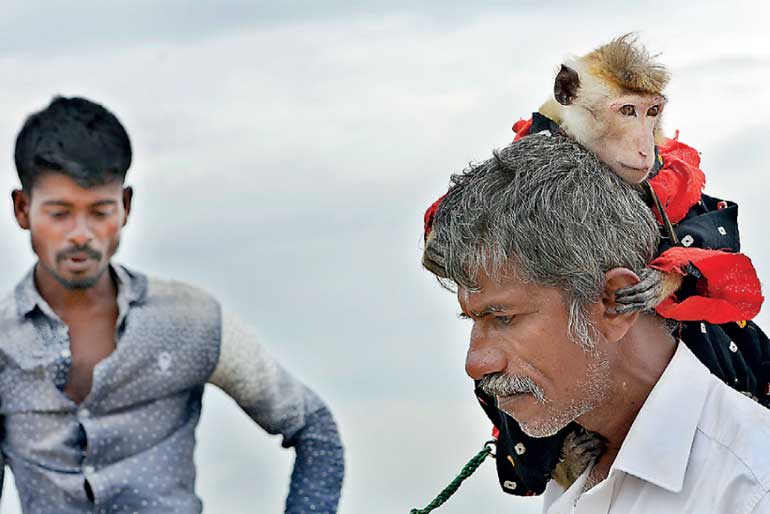Monday Mar 10, 2025
Monday Mar 10, 2025
Tuesday, 20 December 2016 00:00 - - {{hitsCtrl.values.hits}}
Within my past column on sustainable tourism I emphasised the issue of “foreigners only” policies occurring in some touristic areas in Sri Lanka. There have been some comments and reactions to my article which I would like to address in this column.
As it was rightly mentioned, not only are foreigners only policies unsustainable for the development of a long-lasting functioning tourism industry of a country, other practices such as for example the abuse of animals as tourist attraction, sexual harassment committed by tourists and by locals towards tourists, artificial increase of prices for tourists without any correlation to the value of the service or product or environmental harm created by touristic activities are also similarly harmful for a healthy development of the tourism sector.
 A monkey trainer with his monkey at Galle Face Green. While most visitors know that snake charming or taking pictures with dressed monkeys on the beach are unsustainable practices, activities like elephant back riding are highly advertised in many Asian countries – Pic by Shehan Gunasekara
A monkey trainer with his monkey at Galle Face Green. While most visitors know that snake charming or taking pictures with dressed monkeys on the beach are unsustainable practices, activities like elephant back riding are highly advertised in many Asian countries – Pic by Shehan Gunasekara
As mentioned previously, in general tourists love Sri Lanka for the many natural and cultural attractions it offers. Where we receive all sorts of tourists, those who live sustainable practices and those who don’t, it is the responsibility of the respective establishments and service providers to assure that there is no harm caused for either Sri Lanka or the tourists.
Many visitors won’t be aware that riding elephants, touching turtles or corals, or driving close up to an elephant or whale in a national park/during whale watching can cause harm to the animals. While most visitors know that snake charming or taking pictures with dressed monkeys on the beach are unsustainable practices, activities like elephant back riding are highly advertised in many Asian countries – sadly reports like the following come to light.
This is a story from Vietnam reported by the ‘Dodo,’ a website which shares specifically content on animal stories worldwide “The elephant was forced to work in the tourist industry, giving holidaymakers rides on her back. She likely died, Thahn Nien News reported, from exhaustion. Sadly, the animal’s death wasn’t an anomalous event. In March, a 40-year-old captive male elephant also died from severe exhaustion and overwork in the tourism industry, according to local news reports. A 36-year-old male elephant collapsed in January for the same reason: he was found dead with chains still on his front leg. In 2013, two female elephants also died in Vietnam — again, from overwork and hunger.”
One problem is how animals are treated and so far I have not heard similar stories from Sri Lanka. Where there are acknowledged establishments in Sri Lanka which have a good reputation of caring for the animals, the question is – should naturally wild animals be kept for tourist purposes at all – making it worse if they had been caught from the wild compared to been born in a sanctuary.  Finally animal rights organisations refer to harm to the animals health is caused by riding them or often by “only” touching them.
Finally animal rights organisations refer to harm to the animals health is caused by riding them or often by “only” touching them.
Nowadays responsible tour agents are not offering such activities anymore, there are various debates ongoing in forums and tourism related discussions to make tourist aware of the situation and to highlight sustainable solutions.
Sri Lanka is known for its beautiful elephants, tourists can watch them in Minneriya National Park, Wilpattu National Park, Yala and so on… there, based on a reasonable system of cars which have access to the parks per day, they can explore the true nature of this animal without creating harm to them. Similarly turtles can be seen during snorkelling rather than in hatcheries where tourists touch them and carry them around.
Awareness needs to be raised among industry members (internationally and nationally) to include such important information into their tours and offers, to come up with packages which offer sustainable activities for tourists, and to inform tourists about the possibilities of sustainable tourism depending on locality. The majority of tourists want to see animals and touch them and be close to them because they like animals, being not aware of the harm they create, they are likely to reward those service providers who promote watching animals in freedom in their natural habitat. However the correct information needs to be delivered to the visitors.
Another aspect which was mentioned related to my last column was that within Sri Lanka there are large inequalities persisting especially disadvantaging ethnic minorities. As this is a very comprehensive topic by itself where the reasons for these group based inequalities are manifold and complex, I will in this article only look at the link to tourism.
Where under colonial times a foreign country was occupying Sri Lanka, nowadays it is Sri Lankans looking down on Sri Lankans. This is also what I intended to highlight within the past column, the foreigner only policy is set up by Sri Lankans against Sri Lankans.
Just a few days back some tourists reported again to me that they observed this policy and they were confused about it as in why such policy was in place; furthermore they perceived it as saddening as they came to Sri Lanka to get to know the country including its people which includes sitting with them in the same restaurant, hotel or bar.
Sri Lanka is blessed with a diversity of cultures, religions, ethnicities and traditions – it is a melting pot of people since centuries, also due to its strategic position in the Indian Ocean and the many traders and travellers who have come to the island. This diversity is what makes the island so fascinating.
What many don’t know is that we have 23 numerically small ethnic groups in Sri Lanka which all have their own food and traditions and some their own language and religion (Veddha, Coastal Veddha, Portuguese Burgher, Bharatha, Malay, Malayali, Chinese, Kaffir, Bohra, Memon, Dutch Burgher, Telegu, Chetti, Indian Tamil, Sindhi, Gujerati, Moor, Kojah, Paadi, Mukkara, Eurasian, Maldivian, Panniyar).
Even within the main ethnicities, the Sinhalese, Tamils and Muslims, there are various sub communities with their specific traditions and heritage. We have towns where a mosque is built next to a church next to a temple and a kovil, which is unique compared to other countries. As those who lived through the long-lasting conflict will know much better than me, peace is the basis for anything else developing in a country. And unrest thrives from inequalities.
Therefore, if we come back to sustainable tourism, Sri Lanka counts on its tourism industry and the revenue created, which is supposed to rise largely in the years to come. Therefore, group based inequalities are not only harmful for a healthy development of a country, they are a large risk factor for various industries too.
Within the ‘12 Aims of Sustainable Tourism,’ the UNEP and UNWTO list the following related key points:
Finally, the sustainable tourism magazine ‘Spotlight on Sustainable Tourism SOST’ outlines in their inaugural edition already in March 2012: “Sustainable tourism is not a choice, it is an imperative – when it comes to an industry that will host u to 1.8 billion tourists by 2030 sustainability must be the top priority for all tourism operators and stakeholders.”
The interested reader can find numerous examples of successful sustainable tourist projects across countries. Not only the tourism related authorities especially the service providers themselves are urged to learn from those and tackle the outlined challenges because animal cruelty and ethnic or social discrimination can have no place in a country which relies on a thriving tourism industry.
Discover Kapruka, the leading online shopping platform in Sri Lanka, where you can conveniently send Gifts and Flowers to your loved ones for any event including Valentine ’s Day. Explore a wide range of popular Shopping Categories on Kapruka, including Toys, Groceries, Electronics, Birthday Cakes, Fruits, Chocolates, Flower Bouquets, Clothing, Watches, Lingerie, Gift Sets and Jewellery. Also if you’re interested in selling with Kapruka, Partner Central by Kapruka is the best solution to start with. Moreover, through Kapruka Global Shop, you can also enjoy the convenience of purchasing products from renowned platforms like Amazon and eBay and have them delivered to Sri Lanka.
Discover Kapruka, the leading online shopping platform in Sri Lanka, where you can conveniently send Gifts and Flowers to your loved ones for any event including Valentine ’s Day. Explore a wide range of popular Shopping Categories on Kapruka, including Toys, Groceries, Electronics, Birthday Cakes, Fruits, Chocolates, Flower Bouquets, Clothing, Watches, Lingerie, Gift Sets and Jewellery. Also if you’re interested in selling with Kapruka, Partner Central by Kapruka is the best solution to start with. Moreover, through Kapruka Global Shop, you can also enjoy the convenience of purchasing products from renowned platforms like Amazon and eBay and have them delivered to Sri Lanka.